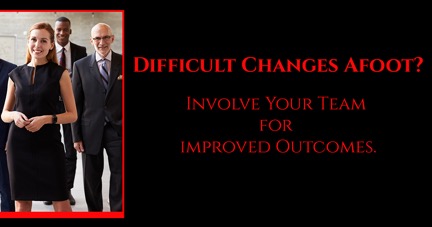Difficult Changes Afoot? Involve Your Team for Improved Outcomes
Difficult Changes Afoot? Involve Your Team for Improved Outcomes https://csuiteold.c-suitenetwork.com/advisors/wp-content/themes/csadvisore/images/empty/thumbnail.jpg 150 150 Dr. Rachel MK Headley https://secure.gravatar.com/avatar/904f999f45a67feadd5860cfd4a73219?s=96&d=mm&r=g
Difficult Changes Afoot? Involve Your Team for Improved Outcomes.
We already know that a killer team is vital to achieve the results and disruption that you want. They are your clever people – the ones you fight to keep, the ones you depend on.
When times get rough, I’ve seen leadership go behind closed doors and make “tough decisions” regarding staffing, solutions, new directions without their team’s input.
Yes, that executive team has to make the decisions. But are they the best decisions? Are they considering all the options? Do they understand the facts on the ground (and not just on the spreadsheet)?
Case Study
An organization conducted a nationwide search and hired a new President. This new President had an agenda – he wanted to start the organization growing in a new direction. But, that meant that some other projects had to get cut – or that was what the executive team decided. Only so much funding to go around, after all.
The new President ended up firing around 40 people and canceling entire projects to make more money available for his new work.
This caused mass confusion in the other projects, because the people and projects that were cut were not poor performers – it was the opposite – one of the projects won a nationwide award just days after the announcement of its impending suspension.
The prevailing hallway conversation consisted of “if they cut those high-performing people, am I next?” And “if they cut that award-winning project, is my project safe?”
Instead of making immediate progress on his new ideas (which were actually very good), he got resistance and resentment. All of which could have been avoided. Now, years later, he has still not gained the trust of the wider organization.
An alternative approach
First, in this context, the basic assumption that there is only so much money to go around was … wrong.
And I wonder if they even realized that they were making that assumption.
If those executives would have approached the teams in jeopardy and said – “Here’s our current thinking. Convince us why we’re wrong. What could we do differently to keep you doing your great work?“
Those teams would have come up with innovative and creative solutions. They may not have worked in the end, and it might have taken more time, but the conversation would have broadened significantly, and an alternate solution may have been discovered.
The decision to keep the teams out of the loop created a tension and distrust immediately across the organization that was simply unnecessary.
Barriers to involving teams
As in all things business, it’s the humans that make the difference, for good or ill. And, while your teams can help solve problems, it’s not an easy approach (but, what great leadership technique is easy, really?!).
The biggest barrier to involving teams is the anxiety that will be stirred by the impending changes.
Particularly with a new executive, a team can’t trust that their head will not get chopped off if they stick their neck out. However, if the leadership had prepped the organization correctly, with the proper communication, and the right ‘we’re all in this together’ mindset, productive conversations are possible. Even vital.
The harder the conversation, the sooner you should have it, not later.
The other major barrier is confidentiality. There are some cases where you simply can’t have a lot of people knowing what is going on. However, even if you can’t be completely public, there are still individuals embedded within the teams that you could bring in to contribute to the conversations.
Always beware the stories we tell ourselves how it “has to be.”
The Big Win
As an organization moves through the change transition, it is up to the leadership to determine if amazing new progress is achieved, or if the organization tanks into disarray and distrust.
The good news is that if you guide your organization well, your team will be stronger, more engaged, more committed, and be your biggest advocate.
In the case above, even if the exact same projects had been canceled in the end, the process would have been transparent, the rest of the teams would have understood the decision-making process, and the President could have made a lot more progress on the work that he wanted to achieve.
Go Forth
In the end, you want your organization to come through difficult changes intact. You want to keep your best people, improve productivity, increase engagement, create more impressive results.
Today might be an epic day, with nothing contentious in sight. You should still be preparing for tough times in the way that all great leaders do:
- Provide an environment where your team feels that they can be honest and openly contribute new ideas.
- Practice transparency. Smart people want to understand what’s going on.
- Be aware of your assumptions, and how they play out in your decision-making.
- Decide ahead of time how you will handle difficult changes before they arrive. You don’t want to be winging it when everyone is anxious.
Difficult changes can really bring down an organization when led poorly. In fact most change fails during implementation.
Be the exception.

